

Certain terminology will be used to describe various fundamentals, either skill specific or tactical, so as to create a constant.
1- Gross observation: Observation on a large scale (i.e. whole ice surface including all players).
2 - Fine observation: Observation of immediate surroundings. Relevant information, spacing, location, number of, etc.
3 - Gross tactical: Describes those theories that include the involvement of a minimum of 3 players such as during a two on one situation to a 3 on 2 and up.
4 - Fine Tactical: One on one environment. Those theories relevant to this situation.
5 - Macro-Skill Set: Those skills such as skating, puck handling etc involved in Gross Tactical.
6 - Micro-Skill Set: Those fundamentals such as balance, step in, crossover, etc involved in Fine Tactical.
7 - Multi-Tasking: Performing more than one mental or skill component/fundamental at the same time.
The following diagrams explain the relationships of above definitions to each other.
Diagram No. 10 - Skills (Micro and Macro) and Skill Sets (Micro and Macro) Analysis
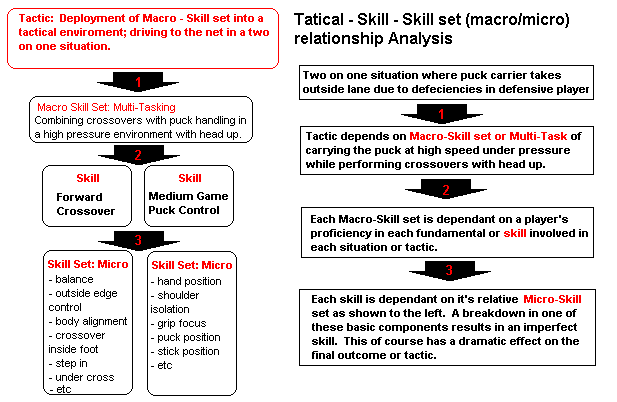
The following diagram represents observation / mental progression. A player's thought process has to progress naturally from event to execution. An "event" can happen directly to a player who would be directly involved (called a Primary) or to someone else called a Secondary (original player then becomes indirectly involved). Events can be categorized into one or more subsets.
1 - a player can pass to primary or to secondary
2 - a puck can rebound to primary or to secondary
3 - an opposition can check the primary or the secondary
4 - an infraction can happen to the primary or the secondary
5 - an opposition player can shoot at the primary or secondary (block shot or GT)
6 - an opposition player can fake the primary or the secondary
7 - a team-mate or coach can direct the primary or the secondary

Once an event takes places, the primary player has to make a decision or figure out "how to react". This reaction process can again be
categorized into several subsets as shown below.
1 - How do I: this question deals specifically with skill integration.
2 - Why should I: Depending on whether primary or secondary, specific tactical options are considered.
3 - When should I: Relative to time. Immediately, in a second from now, or later.
4 - Where should I: Relative to space. Should I stay in this space or move to a new location (into open ice for example).
5 - Who else is involved: Moving from fine observation phase into gross observation phase.
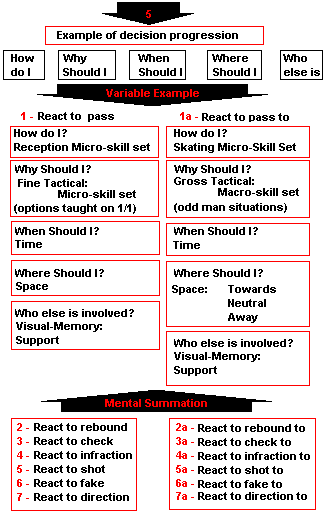
Decisions can then be broken down into two basic decisions; those involving skills and skill sets, i.e." take a slap shot" and those involving fine tactical and gross tactical, "how do I play this two on one". However, it is important to understand that the success of each Tactic is totally dependant and the corresponding skills ( Macro Skill Set) inherent with application. Each Skill utilized in a specific tactic has corresponding components (Micro Skill Set) which determine overall success of associated skill. A player that has poor upper body alignment and outside edge control will have limited success when trying to accelerate to wide ice using crossovers. Improper hand separation (shaft speed) as well as upper hand extension (pulling action) will limit medium and long range shooting effectiveness of the wrist shot. Without getting into too much detail on skill integrity, tactics are dependant on skills, and skills dependant on skill set components.
Establishing short, medium and long game philosophies is an age-old strategy of war-fare. Sun - Tzu describes this in his text, "The Art of War". Knowing where and when to use skills and tactics depends on a players ability to "SEE" the game both from a "gross" (overall) point of view as well as from a "fine" (focal) point of view. If one is more proficient in one "Game Posture" than another, strategies and/or tactics will degenerate relative to level of executable ability.
What game posture or postures is/are the most important? In 1993 I started a company called Excel Hockey Enterprises. It's objective was to test various skating skills at various levels from beginner to elite, amateur to professional, around the world to establish some form of bench mark for development. Approximately 10,000 tests were done analyzing short, medium and long game skating fundamentals. After analyzing the data, a developmental program was put into place for a team of 15 / 16 year old hockey players from North Delta, British Columbia, Canada that focused entirely on skill development specific to this study. This was during the regular hockey season where most coaches would focus on tactical system training. Less than 5% of 80 practices were devoted to systems. *Visual high speed skill training was the primary focus. Upon completion of our season which included 81 games and over 80 practices our record was as follows:
Record: 73 wins 5 losses 3 ties
Accomplishments: Chilliwack BC Pre-Season Tournament winner
Medicine Hat Alberta Tournament winner - first BC team to ever win tournament
BC Junior Showcase Tournament winners
KHIBIT - Kamloops (BC) Hockey Bantam International Invitational Tournament - winner C Division
Pacific Coast Play-off Champions - no losses
BC Provincial Champions - no loses (7-0-0 record)
Western Canadian Bantam Champions - 1 loss (first time in over 23 years that a BC team had won hampionship).
Notable Accomplishments:
25 shutouts
25 one goal against games
18 two goal against games
454 goals for 83 goals against
Players: Number of players signed by WHL from team (7) 1999-2001 season
*High speed visual training techniques were based on the fact that if a player's Gross and Fine Observation skills were deficient, their decision making process (skill - tactical integration) would be hindered.
Understanding how this mental process works is based on the following model:
Diagram No. 12 -
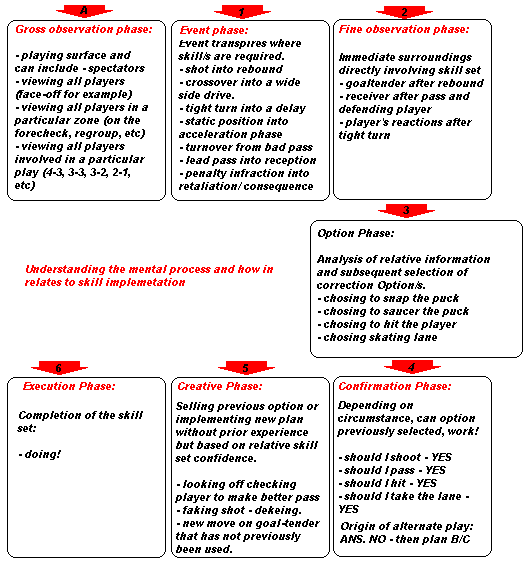
This cycle repeats itself over and over again during the game, moving from one event to another. This cycle of "seeing, decision making, and execution" relies entirely on interaction between the conscious/ unconscious mind, learned or "knowing" experience, and skill level. While a tactical situation may have several different options, a player will only chose those that they "know" or those that they can execute. This is called; "playing within one' limitations". Where a breakdown occurs is when a player is pressured into exceeding their patterns of recognition and they have to try to "improvise". Improvising is directly linked to skills and skill set competence.
Diagram No. 13 -
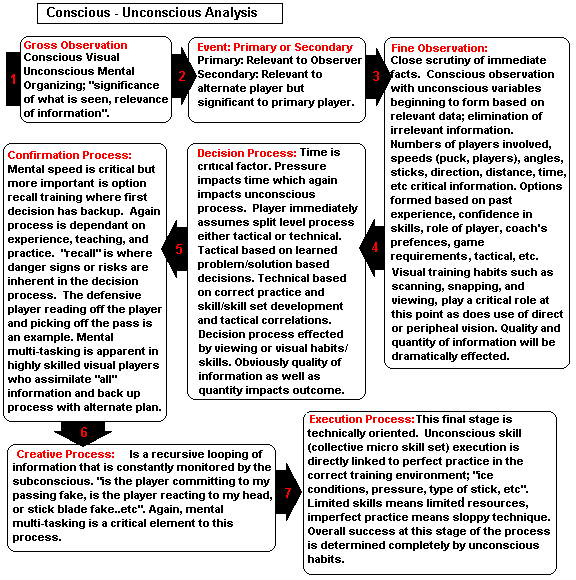
What we must understand is the mental skill set and/or tactical sequencing that takes place. Decisions should follow a natural progression with simple steps (decisions). These decisions should follow a simple "left or right", "forward or backward" mentality. This allows the primary to move through options in a very quick, fluid manner. The example shown below may take only a few seconds depending on opposition pressure.
Diagram No. 14

The following diagram provides a more in depth explanation of the decision making process. In this example we will assume that the player has decided to carry the puck. Each decision has two distinct alternate variables as shown by black arrows. In option 1, the primary has moved into a situation where the opposition has limited his space and forced him to make a decision.
Diagram No. 15
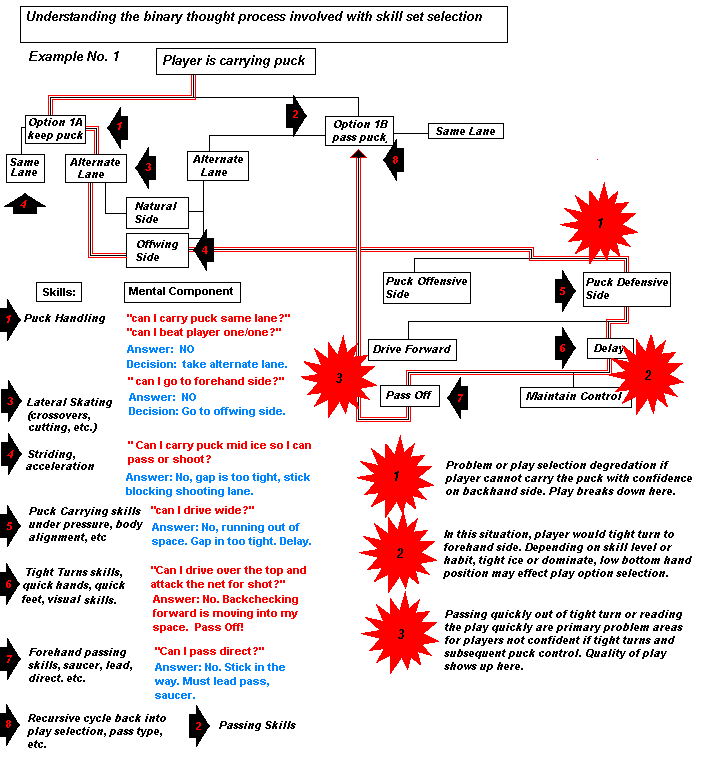
As we can see, proper training both from a negative (what bad thing would happen if I chose an alternate decision) as well as from a positive (what good thing would happen if I chose an alternate decision) point of view is absolutely critical. A player must understand both variables in order to make quality decisions. This mental - skill relationship is a process that cycles back and forth in a dominate role over a player's hockey career. By dominate I mean that one drives the learning or motivation to improve the other. In the beginning of a player's hockey career, the mental cycle is obviously high; "I want to learn how to skate, puck-handle and shoot". This creates the passion for learning the skills of the game. As the skills improve they gradually become the dominate force, driving the mental to learn the game in the tactical sense. "I can skate, shoot and pass but I do not know how to do a 2 on 1 correctly". This cycle moves back and forth. Once a player acquires a new set of skills he must be taught where to use them. Once a player understands more of the tactical side of the game, he knows what areas relative to skill he must improve. This cycle is shown below.
Diagram No. 16 Mental / Skill Cycle Analysis
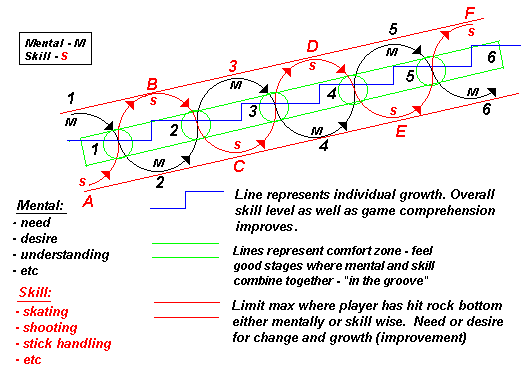
This cycling creates highs and lows in a players career. It then becomes important to understand when a "high" is happening and take advantage of it (when a player is playing "in the groove"). These highs are demonstrated in the cycle as the green circles in the middle. This is where both mental and skill integrate perfectly. The lows are depicted by the red lines running parallel. This would represent a player "slumping" (hasn't scored in ten games, etc.). These cycles are evident in all areas of play' gross or fine, micro or macro. The following diagram represents this cycling overlap.
Diagram No. 17 - Cycle Integration Analysis
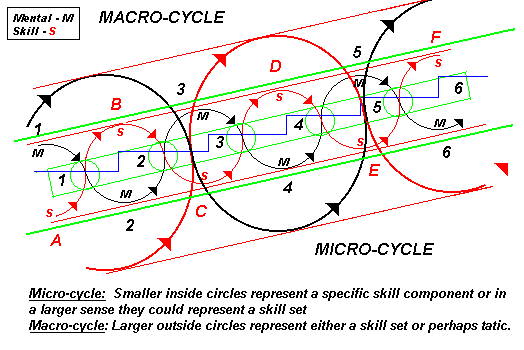
This rotating cycle can be best described using the following example. Lets assume that the micro-cycle is passing skills and the macro-cycle is tactical two on ones. The micro-cycle "mental" component is the need to pass better (1M), the larger macro-cycle is wanting to learn how to perform two on ones properly. Passing skill is low and macro-skill execution (skating, carrying puck and passing) is weak. Player learns how to pass forehand side and understands first rule of 2 on 1 engagement thus the cycles merge and integrate properly at (3C). As an extension of learning how to pass the player learns how to backhand pass better as well as saucer pass. Skills are high but mental execution is weak. New rules of engagement are learned, new cycle develops and merges in next macro - cycle rotation past (F6). There can be many over- lapping cycles involving large team "gross tactical" systems, "fine tactical" systems involving 1, 2 or 3 players, skills, skill-sets or even career cycles. How all of these systems integrate and support each other is absolutely critical to maximizing a player's development.
My C.A.T. System of development is based on the above fundamentals. A hockey player cannot be "created" overnight. A system of analysis and correction is paramount to creating a developmental "road map" that a player can follow for the next 5 to 6 years and in cases of fine tuning fundamentals and tactics, many more years are required.
Any breakdown in execution comes from improper sequential training. The brain has to follow a natural series of decisions that allow a player to move quickly through relevant data and come up with the correct option. I call this process "Binary Integration". This type of training allows a player to think quickly and naturally as long as outcome is known due to prior teaching and/or experience.
Ron
Johnson, President, Technical Director Quan-Tech Sport Systems Inc.
Copyright © 1996 by Ron Johnson. All rights reserved.
Revised:
04 Nov 2009 08:28:43 -0800
.